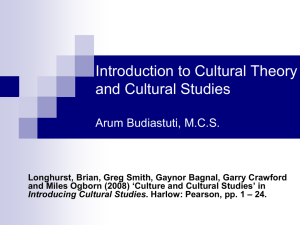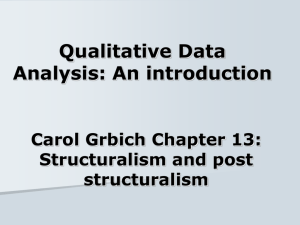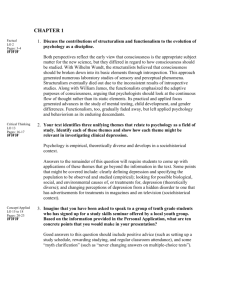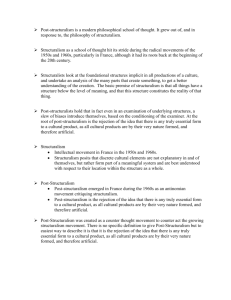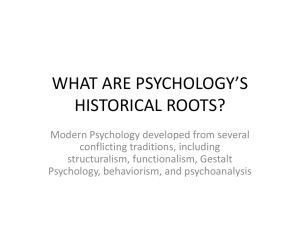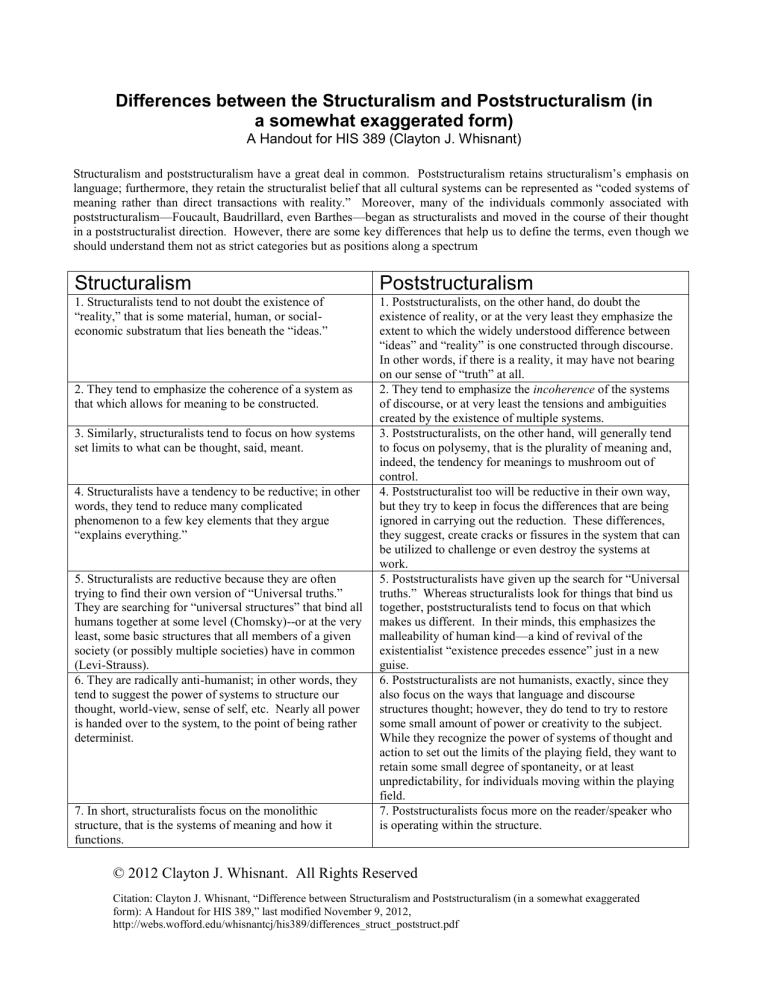
Differences between the Structuralism and Poststructuralism (in a somewhat exaggerated form) A Handout for HIS 389 (Clayton J. Whisnant) Structuralism and poststructuralism have a great deal in common. Poststructuralism retains structuralism’s emphasis on language; furthermore, they retain the structuralist belief that all cultural systems can be represented as “coded systems of meaning rather than direct transactions with reality.” Moreover, many of the individuals commonly associated with poststructuralism—Foucault, Baudrillard, even Barthes—began as structuralists and moved in the course of their thought in a poststructuralist direction. However, there are some key differences that help us to define the terms, even though we should understand them not as strict categories but as positions along a spectrum Structuralism Poststructuralism 1. Structuralists tend to not doubt the existence of “reality,” that is some material, human, or socialeconomic substratum that lies beneath the “ideas.” 1. Poststructuralists, on the other hand, do doubt the existence of reality, or at the very least they emphasize the extent to which the widely understood difference between “ideas” and “reality” is one constructed through discourse. In other words, if there is a reality, it may have not bearing on our sense of “truth” at all. 2. They tend to emphasize the incoherence of the systems of discourse, or at very least the tensions and ambiguities created by the existence of multiple systems. 3. Poststructuralists, on the other hand, will generally tend to focus on polysemy, that is the plurality of meaning and, indeed, the tendency for meanings to mushroom out of control. 4. Poststructuralist too will be reductive in their own way, but they try to keep in focus the differences that are being ignored in carrying out the reduction. These differences, they suggest, create cracks or fissures in the system that can be utilized to challenge or even destroy the systems at work. 5. Poststructuralists have given up the search for “Universal truths.” Whereas structuralists look for things that bind us together, poststructuralists tend to focus on that which makes us different. In their minds, this emphasizes the malleability of human kind—a kind of revival of the existentialist “existence precedes essence” just in a new guise. 6. Poststructuralists are not humanists, exactly, since they also focus on the ways that language and discourse structures thought; however, they do tend to try to restore some small amount of power or creativity to the subject. While they recognize the power of systems of thought and action to set out the limits of the playing field, they want to retain some small degree of spontaneity, or at least unpredictability, for individuals moving within the playing field. 7. Poststructuralists focus more on the reader/speaker who is operating within the structure. 2. They tend to emphasize the coherence of a system as that which allows for meaning to be constructed. 3. Similarly, structuralists tend to focus on how systems set limits to what can be thought, said, meant. 4. Structuralists have a tendency to be reductive; in other words, they tend to reduce many complicated phenomenon to a few key elements that they argue “explains everything.” 5. Structuralists are reductive because they are often trying to find their own version of “Universal truths.” They are searching for “universal structures” that bind all humans together at some level (Chomsky)--or at the very least, some basic structures that all members of a given society (or possibly multiple societies) have in common (Levi-Strauss). 6. They are radically anti-humanist; in other words, they tend to suggest the power of systems to structure our thought, world-view, sense of self, etc. Nearly all power is handed over to the system, to the point of being rather determinist. 7. In short, structuralists focus on the monolithic structure, that is the systems of meaning and how it functions. © 2012 Clayton J. Whisnant. All Rights Reserved Citation: Clayton J. Whisnant, “Difference between Structuralism and Poststructuralism (in a somewhat exaggerated form): A Handout for HIS 389,” last modified November 9, 2012, http://webs.wofford.edu/whisnantcj/his389/differences_struct_poststruct.pdf

